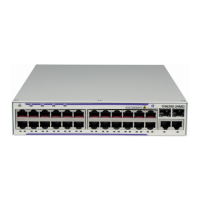RSVP
Page 60 7210 SAS M, T, X, R6, Mxp MPLS Configura-
tion Guide
RSVP
The Resource Reservation Protocol (RSVP) is a network control protocol used by a host to request
specific qualities of service from the network for particular application data streams or flows.
RSVP is also used by routers to deliver quality of service (QoS) requests to all nodes along the
path(s) of the flows and to establish and maintain state to provide the requested service. RSVP
requests generally result in resources reserved in each node along the data path. MPLS leverages
this RSVP mechanism to set up traffic engineered LSPs. RSVP is not enabled by default and must
be explicitly enabled.
RSVP requests resources for simplex flows. It requests resources only in one direction
(unidirectional). Therefore, RSVP treats a sender as logically distinct from a receiver, although the
same application process may act as both a sender and a receiver at the same time. Duplex flows
require two LSPs, to carry traffic in each direction.
RSVP is not a routing protocol. RSVP operates with unicast and multicast routing protocols.
Routing protocols determine where packets are forwarded. RSVP consults local routing tables to
relay RSVP messages.
RSVP uses two message types to set up LSPs, PATH and RESV. Figure 20 depicts the process to
establish an LSP.
• The sender (the ingress LER (ILER)), sends PATH messages toward the receiver, (the
egress LER (ELER)) to indicate the FEC for which label bindings are desired. PATH
messages are used to signal and request label bindings required to establish the LSP from
ingress to egress. Each router along the path observes the traffic type.
PATH messages facilitate the routers along the path to make the necessary bandwidth
reservations and distribute the label binding to the router upstream.
• The ELER sends label binding information in the RESV messages in response to PATH
messages received.
• The LSP is considered operational when the ILER receives the label binding information.
Figure 20: Establishing LSPs
OSSG015
ILER
1
LSR
2
LSR
3
ELER
4
PATH
RESV
LSP
PATH PATH
RESV RESV

